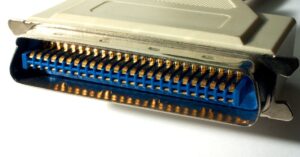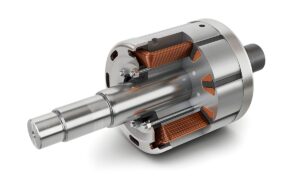 Optical fiber serves as the backbone for many of today’s essential high-speed communications applications, and has been one of the most important technological advances in the modern world. From supporting Internet connectivity for people and businesses to connecting industrial automation systems, optical fibers enable the transmission of vast amounts of data for the services we rely on every day.
Optical fiber serves as the backbone for many of today’s essential high-speed communications applications, and has been one of the most important technological advances in the modern world. From supporting Internet connectivity for people and businesses to connecting industrial automation systems, optical fibers enable the transmission of vast amounts of data for the services we rely on every day.
Since their inception decades ago, optical fibers have typically been designed and manufactured using an approach that involves a thin strip of glass consisting of a single solid glass core through which optical signals propagate, encased in a glass cladding layer of different refractive index. Which helps keep light inside the core during transmission. Along the way, optical fiber has seen many iterations of positive developments, resulting in the fiber we have today delivering data efficiently at unprecedented levels and in a low-loss, low-latency manner.
However, with data demand currently still high in 2024 and expected to continue this upward trajectory for the foreseeable future, leading fiber manufacturers are working on several new designs aimed at increasing capacity, reducing latency, or both. The two types that show the greatest promise for optical fiber in terms of feasibility are hollow core optical fiber (HCF) and multicore optical fiber (MCF), which so far are showing some real improvements in speed, bandwidth and capacity.
Let’s take a quick look at both types of fibers, including their technical makeup and key performance benefits, as well as some examples of brands and fiber companies that are at the forefront of these innovation efforts.
Hollow Optical Fiber (HCF)
Hollow fiber, as the name suggests, is a type of optical fiber whose core is hollow and composed of air instead of solid glass. This unique structural design approach dramatically changes the light propagation properties of the fiber, enabling several performance advantages over traditional fibers with solid glass cores.
Benefits and applications of HCF
There are some technical advantages that can be achieved through the use of optical fibers that enable transmitted light signals to travel through the air instead of through glass.
Low latency: The speed of light is determined by the index of refraction (IOR) of the medium through which the light travels – the higher the IOR, the slower it travels. Air has a much lower IOR value than glass, so HCF allows light to travel faster through its core, dramatically reducing latency by 30% or more, as stated in a white paper by the manufacturer of HCF OFS®. These latency improvements are essential for applications that require real-time data processing, such as high-speed financial trading and autonomous vehicles, which have already implemented some early-stage hollow fiber development in their networks.
Enhanced Bandwidth/Larger Spectrum: HCF’s air core can support a wider range of wavelengths, thus increasing potential bandwidth capabilities. Having additional spectrum available for use is beneficial for high-capacity data transmission and future-proof telecommunications infrastructure.
Low Attenuation: While early versions of HCF showed much higher attenuation (signal loss) compared to today’s conventional glass-core optical fibers, recent improvements by some manufacturers have led to demonstrations showing that HCF can achieve similar low attenuation values required to achieve performance optimum. Often deployed over short distances within data centers up to this point, HCFs anticipate that moving forward to achieve consistently low attenuation values could make these fibers suitable for mass deployment in long-distance, regional, or even subsea/transoceanic transmission applications.
Leading innovators of hollow fibers
While still in the early stages of the technology life cycle, a few well-known companies have been at the forefront of developing high-performance hollow core optical fibers for networking and data center applications.
Note: These major entities are not the only companies manufacturing hollow fiber, as there are many other entities (eg: ThorLabs, NKT Photonics, etc.) that offer HCF for specialty communications.
Multicore Optical Fiber (MCF)
Based on the space division multiplexing (SDM) design concept, a multicore optical fiber is a type of fiber consisting of multiple cores within a single fiber strand. Each core operates independently, allowing multiple data streams to be transmitted simultaneously over individual fibers. This physical multiplexing capability using multiple cores greatly improves the data capacity of each fiber, with dual-core MCF providing twice the amount of data as single-core fiber, and so on.
Benefits and applications of MCF
Higher data capacity: By allowing multiple, independent optical streams to be carried in a single fiber simultaneously, MCF provides a viable solution to dramatically increase network data capacity. In addition, the use of wavelength division multiplexing (WDM) technology, which allows multiple channels of data to be transmitted together in the same signal within the core, greatly increases the amount of data that can be transmitted with a single MCF.
Increased physical capacity and space savings: By offering multiple cores within a single fiber, MCF reduces the need to use multiple independent single-core fibers, thus reducing the overall amount of fiber and cables, saving space in fiber channels and paths, along with reducing the complexity of fiber management in data center environments Dense. As a basic example, using a single patch cable with a quad-core MCF to replace four single-core fiber patch cables saves actual space by 75%.
Enhanced Network Efficiency: With the combined benefits of increased data capacity and space savings, MCF helps simplify and enable more efficient network architectures, able to meet increasing data demands with practical scalability in mind.
Leading innovators of multicore fiber
Like HCF, multicore fiber is still in the early development stage, but there are several examples of notable companies aiming to make a splash which include:
Note: Other companies in this space that also offer multicore fiber include Fibercore and iXblue, to name a few.
The future of HCF and MCF – a look ahead
While traditional single-core optical fibers are unlikely to disappear any time soon, hollow core and multi-core optical fibers appear to represent an exciting next generation of fiber-optic innovation, especially to meet the demands of faster, faster, and more efficient optical fibers. Higher capacity networks. With major industry players such as Sumitomo®, OFS® and Microsoft® making significant investments in the development of these specialized fibers and already indicating real deployments in the data center and financial trading arenas, this future is already here.
It will be interesting to see the direction of HCF and MCF design and production over time, as there are still many questions at the moment regarding their outlook. What will the global demand picture for both types of fiber look like in the long term? Will it eventually largely replace traditional single-core fiber across entire networks or will its use be limited to more specific areas or applications? Will providers prioritize latency benefits and skew more toward HCF or increase capacity and skew more toward MCF?
On the manufacturing side, the competitive landscape is always changing. Who will be able to successfully leverage their resources and expertise to achieve performance advantages along with reliable and cost-effective high-volume fiber production? What technical and manufacturing hurdles will they have to overcome? Will Microsoft® eventually make HCF available to the broader market or will it keep its use internal and/or for specific business cases? Will OFS® and Sumitomo® be able to establish themselves as market leaders for their fibers given their early lead?
It should also be noted that the name of one of the key players, arguably the largest and most influential company in the field of leadership and production of optical fibers, – Corning®, was not mentioned. As of the date of this article, Corning® has not yet made any public announcements regarding its HCF or MCF development or production efforts. However, always at the scientific forefront of new fibers and looking to the future, it will be interesting to see if, when and how they make an impact with these fiber types or if they pioneer an alternative approach altogether.
One thing is certain – the future is bright for developing new optical fibers for high-bandwidth, low-latency networks. At this point, the same can be said for both hollow core and multi-core technology, which are showing performance benefits that match future data delivery needs and expectations.
Request more information
If you would like to learn more about hollow and multicore fibers, or require custom lengths of these fibers for network testing, latency simulation, or optical time delay applications, contact M2 Optics at a time that suits you.



